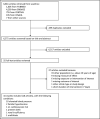Sodium intake and blood pressure in children with clinical conditions: A systematic review with meta-analysis
- PMID: 30489016
- PMCID: PMC8030412
- DOI: 10.1111/jch.13436
Sodium intake and blood pressure in children with clinical conditions: A systematic review with meta-analysis
Abstract
Little is known on the effect of sodium intake on BP of children with clinical conditions. Our objective was therefore to review systematically studies that have assessed the association between sodium intake and BP in children with various clinical conditions. A systematic search of several databases was conducted and supplemented by a manual search of bibliographies and unpublished studies. Experimental and observational studies assessing the association between sodium intake and BP and involving children or adolescents between 0 and 18 years of age with any clinical condition were included. Out of the 6861 records identified, 51 full texts were reviewed, and 16 studies (10 experimental and 6 observational), involving overall 2902 children and adolescents, were included. Ten studies were conducted in children with elevated BP without identifiable cause, two in children with familial hypertension, one in children with at least one cardiovascular risk factor, one in children with chronic renal insufficiency, one in children with urolithiasis, and one in premature infants. A positive association between sodium intake and BP was found in all studies, except one. The meta-analysis of six studies among children with elevated BP without identifiable cause revealed a difference of 6.3 mm Hg (95% CI 2.9-9.6) and 3.5 mm Hg (95% CI 1.2-5.7) in systolic and diastolic BP, respectively, for every additional gram of sodium intake per day. In conclusion, our results indicate that the BP response to salt is greater in children with clinical conditions, mainly hypertension, than in those without associated clinical conditions.
Keywords: blood pressure; cardiovascular risk factors; children; elevated blood pressure; familial hypertension; prematurity; renal insufficiency; salt; sodium; urolithiasis.
©2018 Wiley Periodicals, Inc.
Conflict of interest statement
The authors report no conflict of interest to disclose.
Figures



References
-
- Lawes CM, Vander Hoorn S, Rodgers A; International Society of Hypertension . Global burden of blood‐pressure‐related disease, 2001. Lancet. 2008;371(9623):1513‐1518. - PubMed
-
- Bochud M, Marques‐Vidal P, Burnier M, Paccaud F. Dietary salt intake and cardiovascular disease: summarizing the evidence. Public Health Rev. 2012;33(2):530‐552.
-
- Global Burden of Disease Risk Factors Collaborators . Global, regional, and national comparative risk assessment of 79 behavioural, environmental and occupational, and metabolic risks or clusters of risks in 188 countries, 1990–2013: a systematic analysis for the Global Burden of Disease Study 2013. Lancet. 2015;386(10010):2287‐2323. - PMC - PubMed
-
- He FJ, Li J, Macgregor GA. Effect of longer term modest salt reduction on blood pressure: Cochrane systematic review and meta‐analysis of randomised trials. BMJ. 2013;346:f1325. - PubMed
-
- Graudal NA, Hubeck‐Graudal T, Jürgens G. Effects of low‐sodium diet vs. high‐sodium diet on blood pressure, renin, aldosterone, catecholamines, cholesterol, and triglyceride (Cochrane Review). Am J Hypertens. 2012;25(1):1‐15. - PubMed
Publication types
MeSH terms
Substances
LinkOut - more resources
Full Text Sources
Medical

